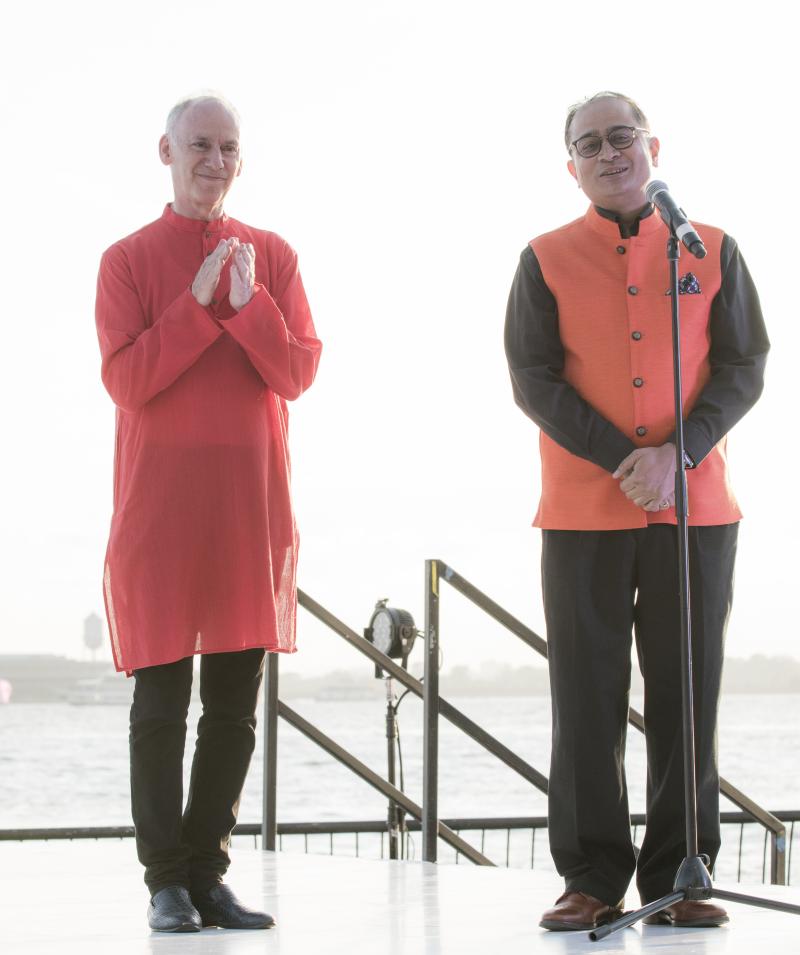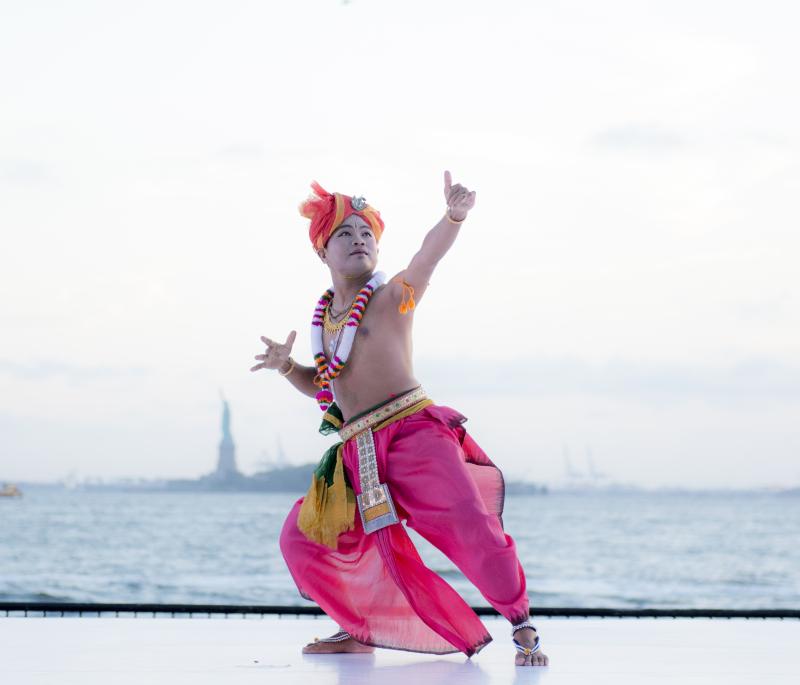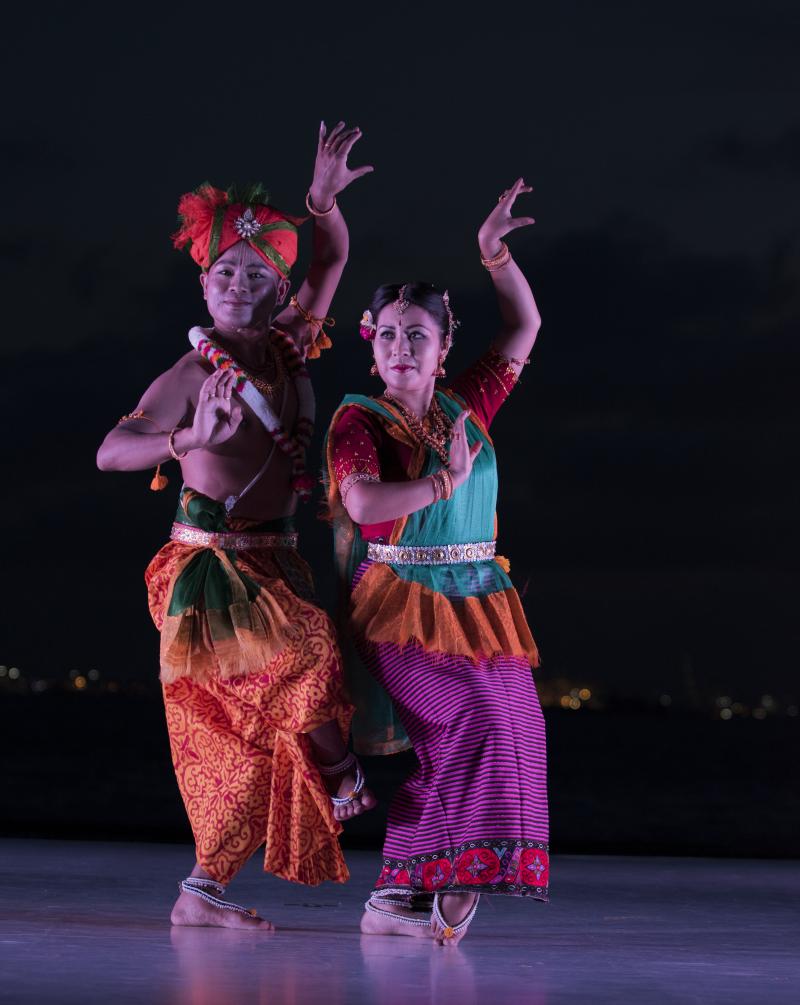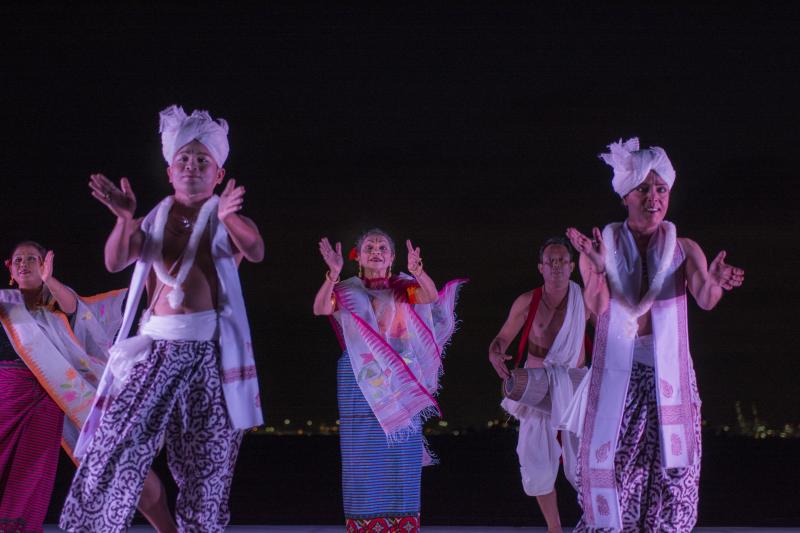India's Independence Celebrates With Lady Liberty At Sunset For Battery Dance Festival

At a time when the world feels so tumultuous and uncertain, where the once United States has become a land and a people divided, events and organizations like Battery Dance are a welcome reminder of what is worth fighting for -- curiosity, discovery, unity, collaboration, sharing, freedom of expression and celebration of our similarities and differences. The 38th annual Battery Dance Festival showcased international artists from the USA, Argentina, Sri Lanka, Austria, France, The Netherlands, Iraq, Italy, Turkey, Lithuania, Norway, South Africa, Romania, Curaçao and India against the breathtaking backdrop of Battery Park (as well as a few indoor locations), where ships sailed by and Lady Liberty stood guard, lifting her lamp in approval of the cultural exchange and global smorgasbord she represents. The yearly event occurs in August when the seasons are starting to shift and the summer is coming to a close. It is free for all New Yorkers and visitors alike, save a special ticketed event at the Schimmel Center at PACE University wrapping up the weeklong extravaganza, a reminder that arts and culture ought to be a right for all, not a privilege for few.

and Sandeep Chakravorty,
India's Consul General of New York
All photos by Juliana Crawford
In acknowledgement and appreciation of rights and freedom, Battery Dance continued its tradition established in 1993 of celebrating India's Independence Day (August 15, 1947) by presenting authentic dance companies from India to New York audiences made possible in part through continued generous support of the Indian Council for Cultural Relations, Consulate General of India in New York and State Bank of India who has been a sponsor for 25 years. This year was a particular treat, with Darshana Jhaveri -- the youngest of the acclaimed Jhaveri Sisters, who had graced the stages of the festival in yesteryear and were the first non-Manipuri-born dancers to perform at the Govindji Temple inside the royal palace of Imphal in 1956 -- returned to demonstrate the richness of traditional Manipuri dance. The dance form is one of the eight major Indian classical dances and takes its name from the Manipur region of its origin, a northeastern Indian state bordering Assam, Myanmar (formerly Burma), Nagaland and Mizoram, which accounts for the variety of cultural influences in the music and dance as well as diversity of features that comprise the faces of Manipuris. The special evening was introduced by Artistic Director Jonathan Hollander and Sandeep Chakravorty, India's Consul General of New York, who shared a warm, familial rapport and camaraderie with each other and a deeply heartfelt respect for the dancers who recreated aspects of Indian life, lore and legends of divine beings and their devotees engaged in passions and play.
The Dances

As with all Indian classical dance, Manipuri is rooted in the ancient Hindu Sanskrit sutras, imbued with local customs, styles and folk dances unique to each region. It is a religious and devotional art form that tends to focus most ardently on themes, songs and stories related to Vaishnavism and the sensuous, love-lorn dance-dramas between Lord Krishna and his bevy of devotees, particularly a beautiful maiden named Radha. One such dance (referred to as Raslila) called "Pontha Jagoi" began the evening while the sun still hung radiantly overhead. Rajika Puri, advisor and Sutradhar (narrator) for Battery Dance Festival performances of Indian dance since 2008, transported attendees to the magnificent majesty of Manipur, by painting a picture of "an abode of jewels" with imagery as poetic and elegant as Rabindranath Tagore as she described "a paradise of lush forests with heady scents" where the Manipuri dance portraying the virile, lascivious and playful god Krishna toys with the hearts of those who worship and adore him. With a face reflective of the youthful god's beauty and spirited, sprightly movements to match, Surbala Devi Bachaspatimayum assumed the role of the divine being, while choreographer Darshana Jhaveri portrayed the Gopi (cowherd girl) Radha, wearing an elaborate Potloi costume called a Kumil that is unique to the region and inspired by Manipuri brides. This highly decorated and vibrantly colored ensemble features a long barrel-like skirt that is stiffened and tapers near the waist giving the appearance of a bell. Though much older than the teenage devotee she played, Darshana embodied all of the shy innocence and delicate femininity of a lovesick young lady utterly awestruck by the feats (and feet) of fancy that Surbala's Krishna demonstrated with furious and fleet movements -- such as rapidly spinning on the knees, encircling the maiden with his omnipresence -- that offset the gentle gestures of the hands and wrists that represented Radha. All of this was performed to lilting vocals and mystical melodies of the sitar, tabla, chimes and flutes, whisking the audience into a meditative trance.

The second dance, "Kamadeva Nartan" performed by Sinam Basu Singh in an unusual theme for Manipuri and set to an eight countbeat, was a tribute to the Hindu god of love Kama who, like Eros, is an archer and shoots arrows of amour into the hearts of the unsuspecting. Only Kama's darts were made of lotus petals, mango blossoms and jasmine flowers and Basu -- resplendent in a turban and tunic in bright pink, vermillion and orange hues that mimicked the setting sun -- strut like a peacock in a pleasure garden as he pranced in sensuous, circular movements, stopping only to draw his bow and aim his floral arrow. The seductive sounds were thick and intoxicating like the fragrance from a love potion with the only interruption of the smooth grooves being the resounding thump when a bolt of ardor is released.
Next, one of the key elements of Manipuri dance was introduced -- the double-headed drum. The percussive instrument called the Pung is a two-sided barrel drum strapped around the neck of the performer that hangs at about hip-level so that they can dance while playing. This is known as the "Pung Cholom" and no Manipuri dance set would be complete without it as a unique and iconic mainstay of the classical Indian dance style. The three performers (Brojen, Angousams and Premkumar Singh), in white turbans and dhotis, created resounding rhythms and played off of each other, stomping their feet to the beat and then suddenly leaping into the air, their cylindrical drums full of expression and gesture as if another limb or extension of their bodies. They are always males, traditionally, but our narrator Rajika Puri explained that there are some females breaking the rigidity of gender boundaries by donning the drums and mastering the art themselves. "There may even be one such renowned female artists in the audience this evening," she noted, beaming proudly at the new progressiveness.

Darshana and Surbala (who performed the introductory dance), returned for "Prabandha Nartan", a soft, graceful piece set to the rhythm of twelve beats. Indian music is very complex and layered -- nothing like the typical four-count rock and pop music of the Western World -- which makes it all the more alluring and enchanting. Puri explained the "feet poetry" and the vocal recitations as being an integral part of Indian classical dance (Manipuri amongst others such as Kathak). The duo once again embodied the robust young god Krishna (played by Surbala) who expressed emotions, intensity and vigor, while the body language and hand gestures of the Darshana as the gentle Gopi devotee displayed feelings such as longing, bashfulness and delight.
The following dance continued with the theme of Krishna but featured the deity as a lusty teenager (played by Monika in the second solo of the evening) chasing ravishing young damsels, a metaphor for the god lures his devotees by "dancing with the human soul" -- pretty exciting and sexy imagery for religion! The piece was typical of the Manipuri repertoire and showcased Monika's Lila (circular dance), lilting movements, delicate hand gestures and the pitter-patter of fleet toes. The melodic music had a floral, feminine and sensual tone with percussive sounds pulsating like a racing heartbeat. As the sole performer, Monika beautifully embodied both the god and Gopis with elegance and expressive storytelling skills.
.jpg)
Brojen, Angousams and Premkumar Singh came back for another round of dancing and drumming for "Dholcholom", a rousing, virile and powerful performance, much like Shiva, the god it celebrates. The dynamic dance utilized two Pung double-headed barrel drums and a pre-Hindu ancient-looking large double-sided drum struck with mallets from Manipuri that was often used at festivals much like the important Hindu festival Holi, Puri explained, where revelers will be doused with water and/or colorful powders. The trio took on the appearance of fierce yet noble warriors preparing for battle and played low, steady beats with precision and martial artistry, garbed in saffron pants and festive garlands.
The founder, lead dancer, choreographer and namesake of the company -- Darshana -- graced the stage for a solo number called "Nayikabhedas" that depicted several of the eight stages of emotions and states of being that the lovelorn heroine goes through while preparing herself to rendezvous with her lover who she pines for amorously. Of course, these being religious dances, the gentleman caller is none other than the god Krishna himself. In this role, the dancer must convey a full and complex story that might feel rather familiar to everyone who's ever been in love and had to deal with all of the concerns, heartaches and uncertainties that come with it. For this, expressions of the face and body through subtle but articulate gestures speak volumes without saying a single word. At first, she is adorning herself in anticipation of his arrival, then becomes heartbroken and forlorn when he does not arrives and destroys her beautifying accouterments in lamentation. He finally arrives to her delight but soon after that joy transforms into explosive anger as signs of affection with another woman are discovered. She casts him out in a fit of rage, then sinks into a pit of despair with her beloved vanquished. Pretty racy (as well as all too human and familiar) stuff for godly devotion!
.jpg)
The following two performances were duets featuring Sanjib and Surbala. The lively 14 beat rhythm piece entitled "Kanduk Khel" was another tribute to, who else -- Krishna -- but instead of chasing and breaking the hearts of Gopi girls, the pair enacted the god and his brother in their more earthly forms as teenaged cowherders, playfully engaging in sports together. They pantomimed tossing a ball (a common theme in depictions of Krishna across most of the classical Indian dances) with slapping feet that acted as additional percussion, joyous leaps into the sky which had shifted its tones to match the rich iridescent hues of their ensembles, and circular spins on their knees. All the while the pair maintained an air of regality despite their spirited youthful mischief. The multi-talented artists were offered the opportunity to showcase their other abilities when double-headed drums were brought out for "Mridang Vadan" where, while seated, they played rapid-fire rhythms while Darshana accompanied with an equally expeditious recitation, all as painstakingly precise as they were seemingly frenzied and swift.

For a shift in subject matter, away from the fanciful foibles of Krishna amongst the cowherders, husband and wife team Basu and Monika evoked the original Lord of the Dance, the all-seeing three-eyed god known also known as the King of Snakes and smeared in ashes from a charnel ground -- Lord Shiva and a devotee (perhaps his wife Parvati). The piece, "Shiva Panchakshara" displayed rich, exotic sounds in rhythms of 7, 12 and a whopping 28 beats, creating a potent, dramatic and mystical feel. This vigorous style is known as Tandav, whereas the more delicate interpretations are referred to as Lasya. Basu was formidable as the God of Destruction (Vishnu, who Krishna is an avatar of, is the God of Preservation) as he struck the iconic pose that can be seen in many depictions of the god in Hindu art and temples. Perhaps Lord Krishna was jealous as the Gopis that he wasn't getting all of the attention for once in the span of the evening, or maybe Vayu, the Hindu deity of the wind was somehow summoned to cause a ruckus, but for a period of time, the lights and the sound went completely off, leaving the dancers in darkness and silence. Consummate professionals and absolute devotees that they were, the two didn't defile the dance but paused like statues and then resumed with purpose and intensity to resounding cheers from the audience when divine intervention allowed the show to go on.

For the finale to conclude the evening's festivities, now with power, sound and light restored, the trio of drummers once again took the stage for the "Kartal Cholom", a circular dance similar to their introductory piece but where two of the percussionists exchanged their drums for brass cymbals which created both clanking, metallic crashes as well as more gentle, melodic tinkles. The effect was meditative, mesmerizing, and in some ways similar to another religious percussive dance, the Buddhist Cham dancers of Bhutan, as they spun and stomped and crescendoed into glorious and thunderous racket enough to rouse the gods from their rest. The full company joined in for the collective clap dance called "Khubakishei", which is often performed at festivals and celebrations in Manipur in June or July and is an exuberant, communal engagement that the New York audience was invited to learn and participate in, once the bows and heartfelt speeches had finished. In Darshana's closing remarks she reflected with a glint in her eye that she had known Battery Park Dance Artistic Director, Jonathan Hollander since 1965, making the homecoming of this event even more remarkable and impactful.
Honoring the Past With a Vision for the Future
It was fitting that Manipuri style performances were chosen to honor and commemorate India Independence Day, because during British colonial rule the dances and dancers were ridiculed as savage, immoral, outdated and ignorant expressions (as were the native cultures and customs, music and dances of Africa, Asia, Australia, South America and the Middle East under colonial rule). Fortunately, thanks to India's independence from such oppression and discrimination, the help of activists, scholars and performers re-establishing and revitalizing many of the nation's ancient yet timeless traditions, and organizations like Battery Dance Festival, Manipuri dance can continue to thrive not only in its country of origin but on the world's stage. Lord Krishna must be pleased!
Comments

Videos
